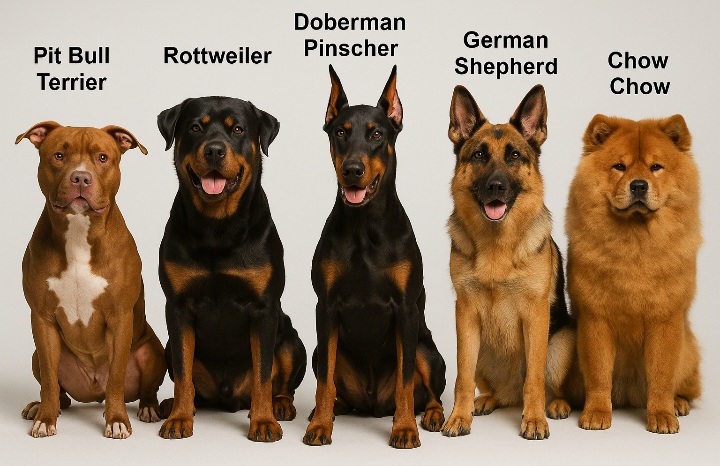By Dickson Bandera
Some dog breeds have gained reputations as dangerous due to their strength, protective instincts, and, in some cases, tragic incidents. However, it’s not the breed alone that poses a risk—it’s how the dog is raised, trained, and managed.
In Zimbabwe and beyond, growing reports of attacks call for a deeper understanding of these breeds and the responsibilities that come with owning them. Below are five breeds often labeled as dangerous, and what they truly need to become safe, loyal companions.
1. Pit Bull Terrier – Strong, Loyal, and Misunderstood
The Pit Bull Terrier has long been at the center of public debate. Muscular and fearless, these dogs are often associated with aggression. But in truth, Pit Bulls are affectionate and highly trainable when raised in a loving, structured environment. The problem arises when they are neglected, mistreated, or trained to be aggressive.
What they need:
Pit Bulls need early socialization with people and other animals to learn calm, friendly behavior. They require firm but gentle training—never harsh punishment—and daily physical activity to channel their high energy. Without these, they may become reactive or destructive.
2. Rottweiler – The Guardian That Needs Firm Leadership
With their imposing build and natural guarding instinct, Rottweilers can be both respected and feared. When properly trained, however, they are intelligent, confident, and loyal family protectors. But they are not for first-time or casual dog owners.
What they need:
Rottweilers thrive on clear leadership and routine. They must be socialized from an early age to avoid territorial aggression. Structured obedience training helps them know their place in the family, while regular mental and physical challenges keep them balanced and content.
3. Doberman Pinscher – Intelligent and Protective by Nature
Doberman Pinschers are sleek, alert, and fast. They make excellent security dogs but can be reactive if not trained and socialized properly. Their strong protective instinct means they must be taught to distinguish between real threats and ordinary situations.
What they need:
Dobermans need early and ongoing socialization to become friendly and confident. They respond well to consistent training and love tasks that challenge their minds. Plenty of exercise is also crucial—without it, their pent-up energy can turn into aggression or anxiety.
4. German Shepherd – Brilliant but Demanding
Used by law enforcement and military units worldwide, the German Shepherd is one of the most versatile breeds. They are loyal, alert, and protective—but also highly driven. If not kept busy and properly guided, they can develop problematic behaviors.
What they need:
German Shepherds need structure, training, and a clear role in the home. They should be exposed to various people and settings as puppies. They excel in advanced obedience and agility, and they need both mental and physical tasks to keep them engaged and well-behaved.
5. Chow Chow – Proud, Aloof, and Potentially Territorial
Unlike the more energetic breeds on this list, the Chow Chow is calm and often aloof. But this independence can lead to aggression if the dog feels threatened or disrespected. Their thick fur and lion-like mane mask a strong and sometimes stubborn personality.
What they need:
Chow Chows must be socialized early to reduce fearfulness and territorial tendencies. They need a confident, experienced owner who respects their space but sets clear rules. Though not highly active, they benefit from regular walks and calm, consistent environments.
Conclusion: It’s the Owner, Not the Breed
Each of these breeds carries potential for both danger and devotion. What makes the difference is the owner. Socialization, training, love, and leadership are non-negotiable. In Zimbabwe, where dog attacks are becoming more frequent, it is crucial to emphasize education over fear. Owning a powerful breed is not about status or intimidation—it is a serious commitment that demands responsibility and respect.


